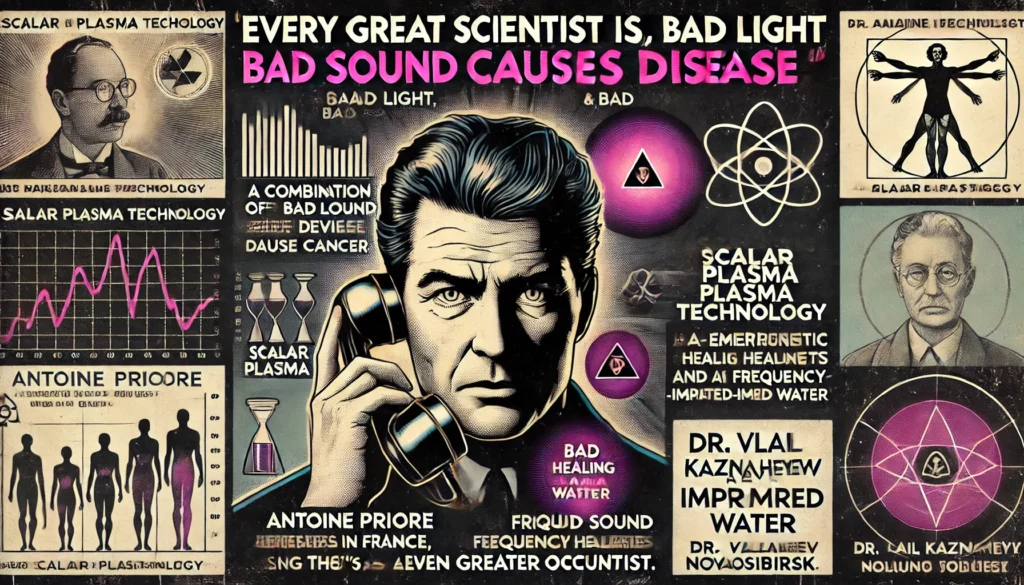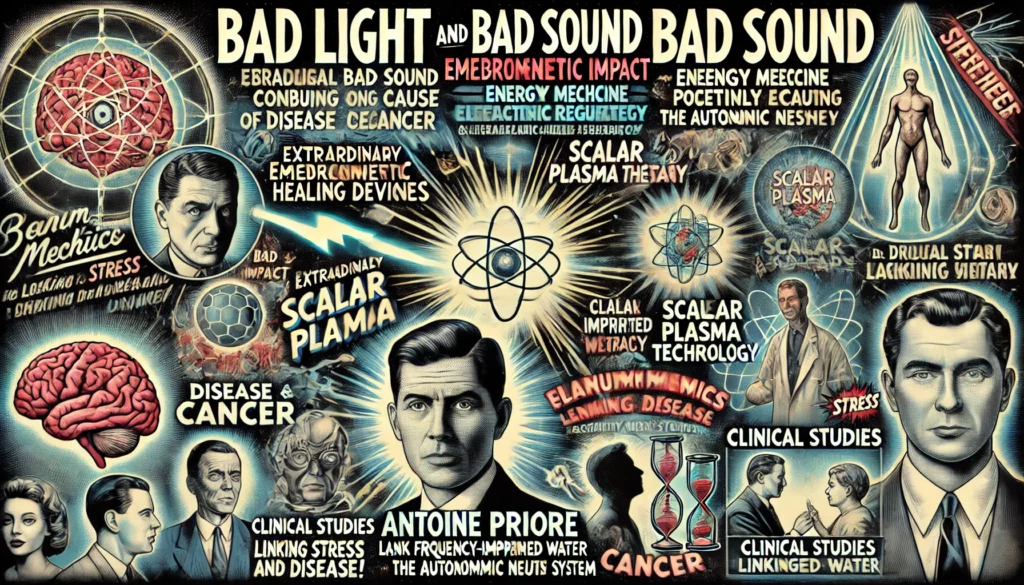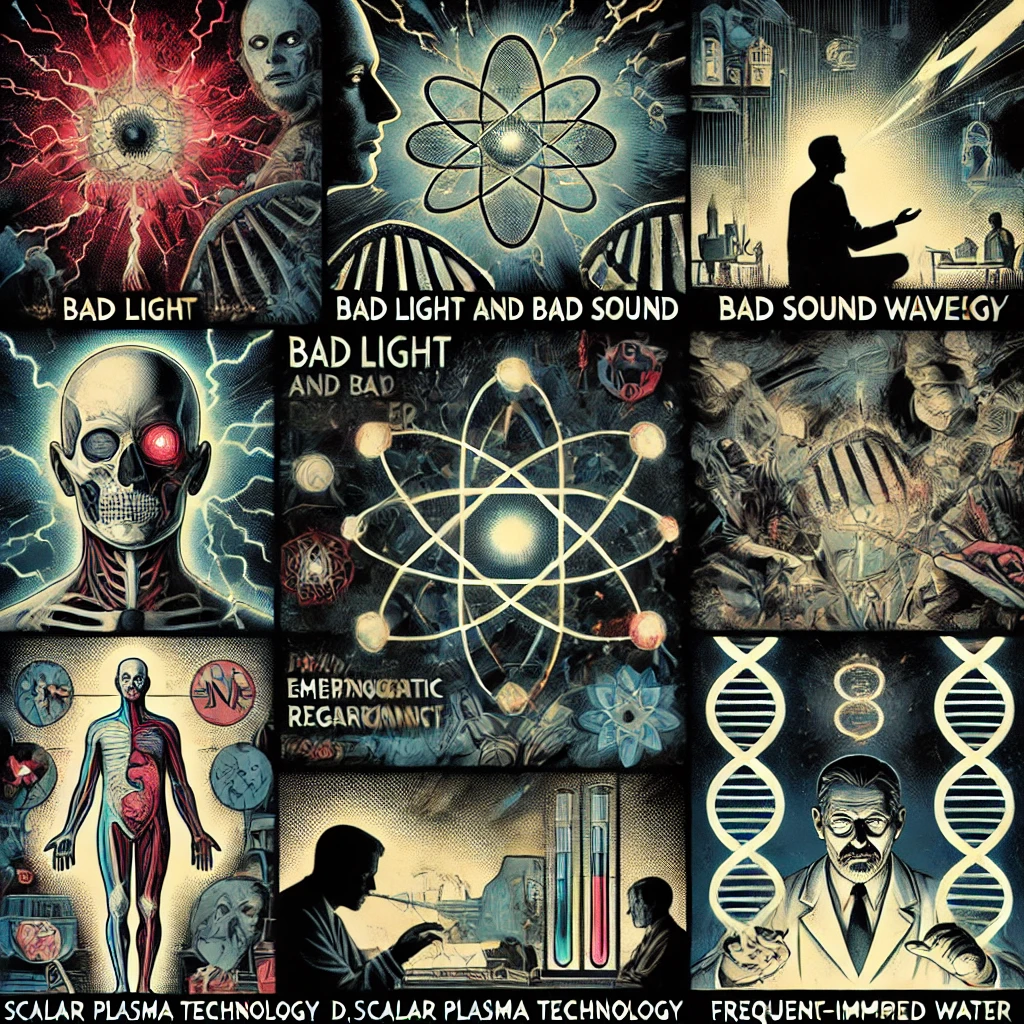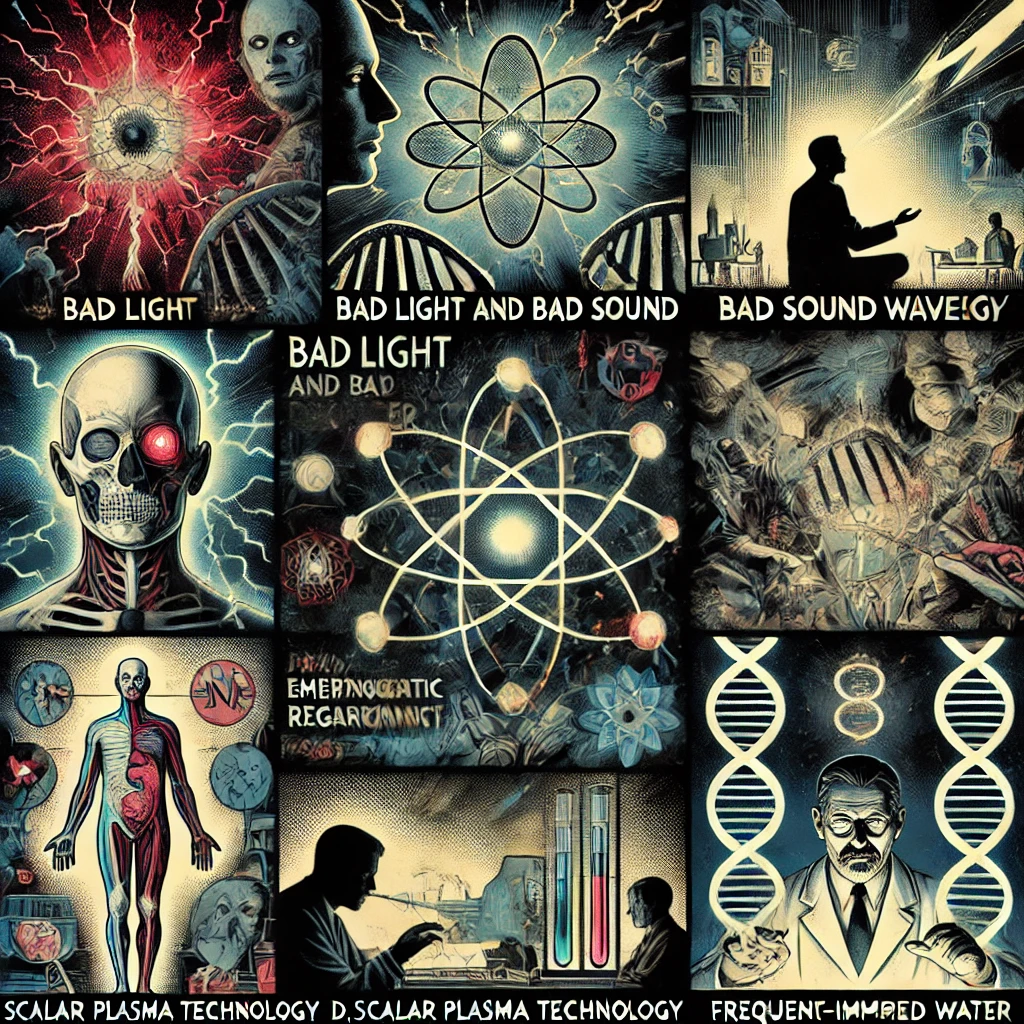Listen to the wrong kind of music in the wrong kind of light … Get cancer
Abstract
“The Kaznacheyev experiments (several thousand) in the Soviet Union proved conclusively that any cellular disease or death pattern could be transmitted electromagnetically, and induced in target cells absorbing the radiation.”
In the 1960’s and 1970’s scalar plasma technology was built and tested in France by Antoine Priore, who created extraordinary electromagnetic healing devices of astonishing efficacy. In the 1970’s, Dr. Vlail Kaznacheyev, director of the Institute for Clinical and Experimental Medicine in Novosibirsk performed some extraordinary experiments. These experiments are vital to understanding disease and healing on a more quantum mechanics basis than is presently utilized by western medical science. In recent years, energy medicine has gained important traction in cancer management and autism spectrum disorder (ASD) by affecting the cellular regenerative system. Scalar plasma technology and frequency-imprinted water was found to have a positive effect on the autonomic nervous system that is responsible for stress management in the human body. Clinical studies have confirmed that stress and disease are intimately related with each other. The data in this case study suggests that scalar plasma therapy combined with frequency-imprinted water can be a promising alternative therapy in stress and cancer management.
…

There has also been other very positive support for the thesis that if living systems transmute elements, they can produce a net source of energy in the process. In 1978 an officially funded effort of the U.S. Army Mobility Equipment Research and Development Command, Fort Belvoir, Virginia positively confirmed that mechanisms for elemental transmutations could occur in biological systems, from an energy consideration. The work was performed under the direction of Emil J. York, Chief of the Material Technology Laboratory. Solomon Goldfein was the principal investigator for the effort. Robert C. McMillan, Chief of the Radiation Research Group of the laboratory, provided guidance on matters of physics and nuclear physics. The abstract of the final report reads as follows: “The purpose of the study was to determine whether recent disclosures of elemental transmutations occurring in biological entities have revealed new possible sources of energy. The works of Kervran, Komaki, and others were surveyed, and it was concluded that, granted the existence of such transmutations (Na to Mg, K to Ca, and Mn to Fe), then a net surplus of energy was also produced. A proposed mechanism was described in which Mg adenosine triphosphate, located in the mitochondrion of the cell, played a double role as an energy producer. In addition to the widely accepted biochemical role of MgATP in which it produces energy as it disintegrates part by part, MgATP can also be considered to be a cyclotron on a molecular scale. The MgATP when placed in layers one atop the other has all the attributes of a cyclotron in accordance with the requirements set forth by E.O. Lawrence, inventor of the cyclotron. ” “It was concluded that elemental transmutations were indeed occurring in life organisms and were probably accompanied by a net energy gain.”
The Kaznacheyev Experiments prove CYTOPATHOGENIC EFFECT, TRANSMISSIBLE VIA LIGHT THRU QUARTZ — “The Kaznacheyev experiments (several thousand) in the Soviet Union proved conclusively that any cellular disease or death pattern could be transmitted electromagnetically, and induced in target cells absorbing the radiation.“
In the 1970’s, Dr. Vlail Kaznacheyev, director of the Institute for Clinical and Experimental Medicine in Novosibirsk performed some extraordinary experiments. For twenty years, he directed highly unusual experiments with twin cell cultures. These experiments are vital to understanding disease and healing on a more fundamental basis than is presently utilized by western medical science. The Kaznacheyev experiments (several thousand) in the Soviet Union proved conclusively that any cellular disease or death pattern could be transmitted electromagnetically, and induced in target cells absorbing the radiation.

In the experiments, two sealed containers were placed side by side, with a thin optical window separating them. The two containers were completely environmentally shielded except for the optical coupling. A tissue was separated into two identical samples, and one sample placed in each of the two halves of the apparatus. The cells in one sample (on one side of the glass) were then subjected to a deleterious agent – a selected virus, bacterial infection, chemical poison, nuclear radiation, deadly ultraviolet radiation, etc. This led to disease and death of the exposed/infected cell culture sample. If the thin optical window was made of ordinary window glass, the uninfected cells on the other side of the window were undamaged and remained healthy. This of course was as expected in the western medical view. However, if the thin optical window was made of quartz, a most unexpected thing happened. Some time (usually about 12 hours) after the disease appeared in the infected sample, the same features of disease appeared in the uninfected sample. This startling “infection by optical coupling” occurred in a substantial percentage of the tests (70 to 80 percent). From a western medical view, these results were unexpected and unprecedented. Furthermore, if the originally uninfected cells were in optical contact with the infected cells for 18-20 hours or so, and then were correspondingly exposed (optically coupled) to another uninfected cell sample, symptoms of the infection appeared in this third sample an appreciable portion of the time (20 to 30 percent).
Guided by A.G. Gurvitsch’s work that showed that cells give off mitogenetic radiation (photons) that can affect other cells, the Kaznacheyev team sought an answer by looking for photons given off by the infected culture sample as its cells died. They found that the cells in the infected culture gave off photons in the near ultraviolet when they died. The normal window glass was opaque to these near-UV photons and absorbed them. In that case, the uninfected culture on the other side of the glass was not exposed to radiation by the UV “death” photons from the dying cells, and they remained serenely healthy. However, the quartz window was transparent to the UV “death photons”. When the quartz window was installed, the UV “death photons” passed through it and was absorbed in the uninfected culture on the other side of the window. Most of the time, the uninfected culture, which absorbed “death photons”, sickened and died with the same disease symptoms. The Kaznacheyev experiments proved conclusively that cellular death and disease patterns could be transmitted and induced electromagnetically.
Scalar-Wave-Cell-Regeneration PDF

Kaznacheyev’s Experiments
The concept you mentioned, known as “Kaznacheyev’s experiments,” is often associated with controversial claims regarding the effects of certain stimuli, such as music or light, on health outcomes like cancer. However, it’s important to clarify that Kaznacheyev’s experiments and the related claims are not scientifically supported and are considered pseudoscientific by the mainstream scientific community. [and yet, meanwhile, “too much sunlight can give you cancer” is a near-mantra and has been so for decades already, claimed “proven”, etc; so the self-contradictions in the Powers That Shouldn’t Be continue in hilarity]
Nikolai Aleksandrovich Kaznacheyev was a Russian scientist who conducted research in the mid-20th century, primarily focusing on the effects of electromagnetic fields on biological systems. His work purportedly involved experiments where he exposed biological samples, such as cells or organisms, to various stimuli, including light and sound, and observed their responses.
One of the most controversial claims associated with Kaznacheyev’s experiments is the suggestion that exposure to certain types of music or light could induce cancer or other adverse health effects in living organisms. However, it’s crucial to note that these claims lack rigorous scientific evidence and have not been replicated or validated by independent researchers.
The idea that listening to the “wrong kind of music” or being exposed to the “wrong kind of light” could directly cause cancer is not supported by credible scientific research. Cancer is a complex disease with multifactorial causes, including genetic predisposition, environmental factors, lifestyle choices, and exposure to carcinogens. While certain environmental exposures may increase the risk of cancer, such as exposure to tobacco smoke or ultraviolet radiation from the sun, there is no evidence to suggest that music or light alone can cause cancer.
In summary, claims regarding the effects of music or light on cancer risk, often associated with Kaznacheyev’s experiments, are not supported by scientific evidence and should be approached with skepticism. It’s essential to rely on credible scientific research and evidence-based medicine when evaluating claims related to health and disease.

